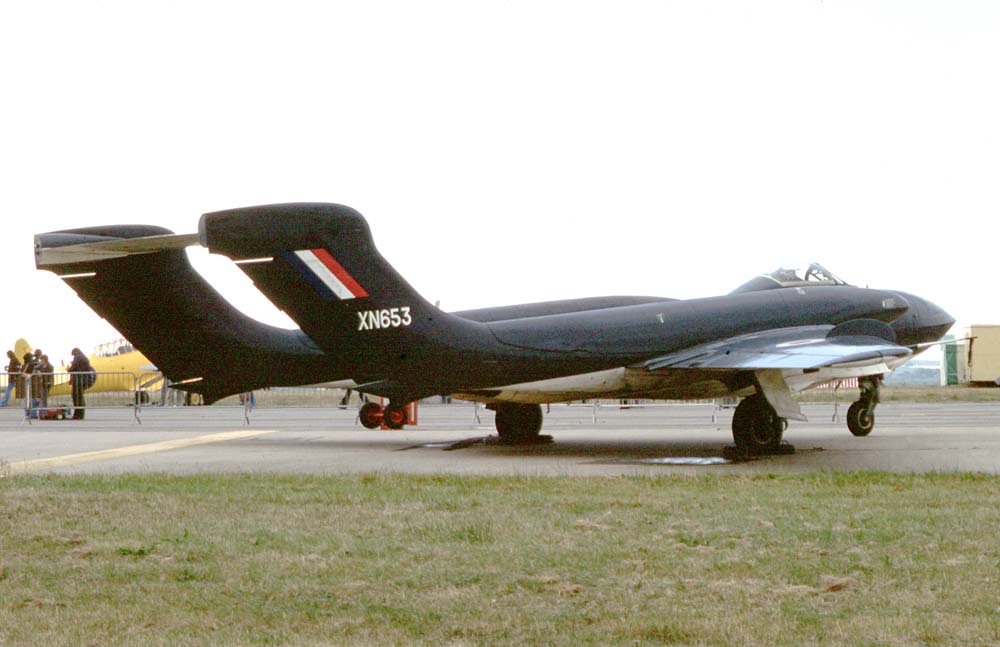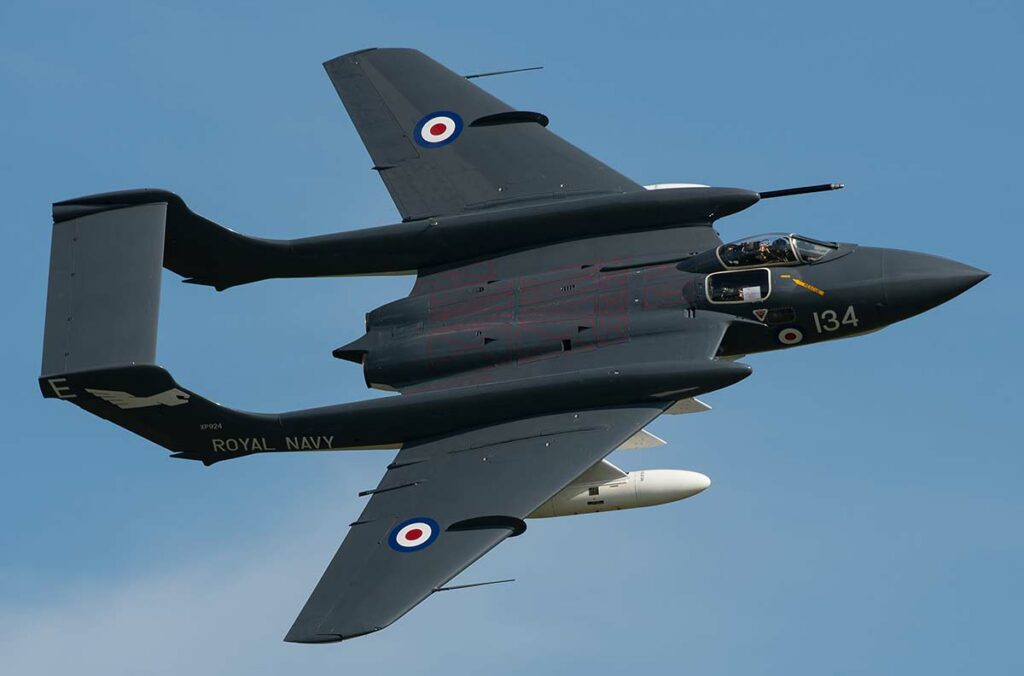British twin-engine, carrier-based fleet air defense fighter with distinctive twin-boom tail and all-weather capabilities.
In brief
The de Havilland DH.110 Sea Vixen was a groundbreaking British naval jet fighter, known for its distinctive twin-boom design and role as the first British two-seat jet fighter to enter operational service. It was equipped with twin Rolls-Royce Avon engines, enabling speeds up to 690 mph (1,110 km/h). The Sea Vixen featured a radar-equipped, all-weather, missile-armed interceptor configuration, capable of operating from aircraft carriers. It served primarily in the fleet air arm of the Royal Navy from the late 1950s into the 1970s, fulfilling roles including air defense, reconnaissance, and strike missions. With its armament of air-to-air missiles, rockets, and bombs, it played a critical role in Britain’s naval air power during the Cold War era.
The de Havilland DH.110 Sea Vixen exemplifies the evolution of post-WWII British military aviation, transitioning from propeller-driven aircraft to advanced jet fighters to meet the demands of modern naval warfare.

History of the Development of the de Havilland DH.110 Sea Vixen
In the aftermath of World War II, the Royal Navy sought to modernize its fleet air arm with jet-powered aircraft capable of defending the fleet against increasingly sophisticated threats. The de Havilland DH.110 Sea Vixen was developed in response to these requirements, initially designed to fulfill both RAF and Royal Navy specifications for a high-speed, all-weather interceptor.
The development of the DH.110 began in the late 1940s, with de Havilland aiming to leverage its experience in jet aircraft to create a cutting-edge naval fighter. The first prototype flew on 26 September 1951, marking a significant milestone in British naval aviation. However, the development journey was marred by tragedy when a prototype disintegrated during a demonstration at the Farnborough Airshow in 1952, leading to a comprehensive redesign to improve safety and performance.
Despite these challenges, the refined DH.110 Sea Vixen emerged as a highly capable aircraft, meeting the Royal Navy’s needs for a carrier-based fleet air defense fighter. It entered service in 1959, becoming the Royal Navy’s first jet fighter designed from the outset to operate from aircraft carriers and the first British two-seat combat aircraft to achieve supersonic speed in a dive.
The Sea Vixen did not receive a specific NATO nickname, a common practice for many military aircraft of the era. Its development and introduction into service represented a significant advancement in naval aviation technology, embodying the transition to jet-powered flight and enhancing the Royal Navy’s air defense capabilities during the Cold War.
Design of the de Havilland DH.110 Sea Vixen
The Sea Vixen’s design was notable for its twin-boom tail configuration, a feature that distinguished it from other carrier-based aircraft of its time. This design choice facilitated the housing of the aircraft’s radar equipment in the nose, allowing for a spacious cockpit with side-by-side seating for the pilot and observer, a unique arrangement among fighters of its era.
Equipped with two Rolls-Royce Avon 208 engines, each producing 11,000 pounds of thrust, the Sea Vixen boasted impressive performance characteristics. It featured a maximum takeoff weight of approximately 46,750 pounds (21,205 kilograms) and was armed with a variety of weapons, including air-to-air missiles, unguided rockets, and bombs, making it versatile in both air-to-air and ground-attack roles.
The aircraft’s all-weather capability was enhanced by its advanced radar system, enabling it to perform fleet air defense missions under any conditions. However, the Sea Vixen’s complexity and maintenance demands, coupled with its relatively large size for a carrier-based aircraft, presented operational challenges.
Despite these drawbacks, the Sea Vixen’s contributions to naval aviation were significant. It offered a substantial increase in capability over its predecessors, providing the Royal Navy with a potent tool for air defense and strike missions during a critical period of the Cold War.
Performance of the de Havilland DH.110 Sea Vixen
The DH.110 Sea Vixen’s performance was a testament to British engineering prowess in the early jet age. With a top speed of 690 mph (1,110 km/h) at altitude, it could reach heights of up to 48,000 feet (14,630 meters), showcasing its ability to intercept high-flying threats. Its range extended to 600 miles (965 kilometers), a considerable distance that allowed it to patrol vast areas around the carrier group.
When compared to its contemporaries, such as the American F-4 Phantom II, the Sea Vixen held its own in terms of operational capabilities, though it fell short in terms of speed and payload. Nonetheless, its unique design and all-weather radar capabilities made it an invaluable asset to the Royal Navy, particularly in the realm of fleet air defense where its ability to operate in adverse conditions was paramount.
Variants of the de Havilland DH.110 Sea Vixen
The Sea Vixen saw several variants throughout its service life, each designed to enhance the aircraft’s capabilities and address specific operational needs. The initial production model, the FAW.1 (Fighter All Weather Mk 1), was followed by the improved FAW.2, which featured folding wings for better carrier storage, an increased fuel capacity, and enhanced armament options, including the addition of Red Top air-to-air missiles.
Additionally, there were proposals for further variants, including a ground-attack version and an electronic countermeasures (ECM) model, though not all of these entered operational service. Each variant of the Sea Vixen underscored the adaptability of its design to meet the evolving requirements of naval warfare.

Military Use and Combat of the de Havilland DH.110 Sea Vixen
The Sea Vixen served primarily in the fleet air arm of the Royal Navy, where it played a crucial role in air defense during the 1960s and early 1970s. Though it did not engage in direct combat, its presence as a carrier-based interceptor was a significant deterrent during the Cold War, particularly in crises such as the 1961 Kuwait crisis and the 1964-1967 Indonesia-Malaysia confrontation, where it conducted patrols and showed force.
The aircraft’s armament, including air-to-air missiles and unguided rockets, equipped it to engage a variety of targets, though its primary role remained air defense. The Sea Vixen’s operational history reflects its effectiveness in this role, contributing to the security of British naval forces during a period of global tension.
Compared to its contemporaries, the Sea Vixen was unique in its design and capabilities. While aircraft like the American F-4 Phantom II eventually surpassed it in performance and versatility, the Sea Vixen’s contribution to British naval aviation and its role as a deterrent during the Cold War are undeniable.
Following its service with the Royal Navy, the Sea Vixen was retired in the early 1970s, replaced by more advanced aircraft like the F-4 Phantom II. However, its legacy endures, with preserved examples serving as reminders of a pivotal era in military aviation.
The de Havilland DH.110 Sea Vixen stands as a symbol of British innovation in the early days of jet-powered naval aviation. Its distinctive design, all-weather capabilities, and operational flexibility made it a key asset for the Royal Navy, reflecting the challenges and technological advancements of the Cold War era. While it may have been eclipsed by newer aircraft in later years, the Sea Vixen’s contributions to naval air defense and its role in British military history remain significant.
Back to the Fighter Jet section.